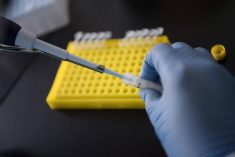WINNIPEG — Pulse crops breeders have had some success in developing varieties of peas and lentils with genetic resistance to root rot.
Researchers from the University of Saskatchewan have developed lines of peas with partial resistance to aphanomyces, a stubborn soil pathogen that causes root rot.
“Some promising lines are now in registration trials,” said Tom Warkentin, a field pea and soybean breeder at the U of S, in 2023.
Read Also

New program aims to support plant-based exports to Asia
Understanding the preferences of consumers in Taiwan and how they differ from Indonesia or Malaysia isn’t easy for a small company in Saskatchewan.
Breeding peas with root rot resistance took years, because many genes in the plant collaborate to provide the resistance. Researchers had to identify resistant genes in peas from other parts of the world, then breed that into pea varieties that are strong performers in Western Canada.
With that complexity in mind, scientists with the National Research Council are taking a different approach to the root rot problem.
Is it possible to remove the genes that make lentils or peas susceptible to aphanomyces and other root rot pathogens?
“(It’s) not easy to get complete resistance … that’s why we’re also looking (at) the susceptibility part of it,” said Pankaj Bhowmik, a senior research officer with the NRC in Saskatoon.
“From my understanding … there are two mechanisms for disease resistance. One is through your resistance genes … the other is susceptible genes.”
Western Canadian growers need solutions to the root rot problem, because aphanomyces has become a chronic challenge for pea and lentil growers. Spores from the disease have infected thousands of fields in Western Canada.
“Aphanomyces root rot causes severe damage to the roots, causing infected plants to wilt and die prematurely. In wet years, high yield loss in peas has been observed under … high infections,” says the SaskPulse website.
Once established in a field, aphanomyces spores can persist for years. In many cases the only feasible strategy is waiting six years or more before planting peas and lentils again.
Bhowmik is hoping to change that. He is using gene editing technology to eliminate the genes that could make lentils susceptible to root rot.
Of course, he needs to know which genes to delete and plant pathologists and other experts at the U of S have provided genetic targets.
“If you have a target, if you know a gene is potentially contributing to this negative (trait) … you can inactivate it (with gene editing),” Bhowmik said from his office in Saskatoon.
“That’s why (we’re looking at) the susceptible genes pathway, for lentils, in this project.”
After he deletes the target genes, other researchers in the project will test the gene-edited plants in the greenhouse to see how they respond to aphanomyces and other root rot pathogens.
The concept of deleting problematic genes in crops is realistic thanks to gene editing technology.
Genome editing, or gene editing, involves changing the genetic code of a plant with technology like CRISPR-Cas9, a technique used to cut sections of DNA. Scientists from California and France won the 2020 Nobel Prize in Chemistry for their discovery of CRISPR.
Plant scientists from America, India, China, South America, Australia, Japan and elsewhere are spending time and resources on gene editing because it could be used to make crops more resistant to disease or the extreme weather associated with climate change.
In this case, Bhowmik emphasized that his work is fundamental research.
There are no plans to introduce a gene-edited pulse crop in Canada.
“We don’t commercialize. We don’t release as a variety at NRC,” he said. “Our focus is … understanding these genes.”
Even if Bhowmik and his colleagues are successful and find that deleting susceptible genes provides some root rot resistance, it’s unlikely that western Canadian growers will plant gene-edited lentils or peas anytime soon.
Major markets like India and China might accept gene-edited crops from Canada, or they may not.
That uncertainty prompts Canadian plant scientists to take a ‘go slow’ approach.
“Let’s face it, the ag industry is quite excited about this technology …. Farmers are excited about having more tools in the tool box,” said Greg Cherewyk, president of Pulse Canada.
“(But) the position really has to be — our key export markets are still reviewing the approach (to gene editing).”
The NRC research is representative of a bigger opportunity for Canada’s crop industry. If plant scientists can identify genes connected to an undesirable trait, eliminating those genes should produce a better crop.
Removing the genes in field peas that give the pea a ‘beany’ flavour, for instance, could open new markets for peas and pea protein.
“Every day, we are finding new applications (for gene editing),” Bhowmik said.


















